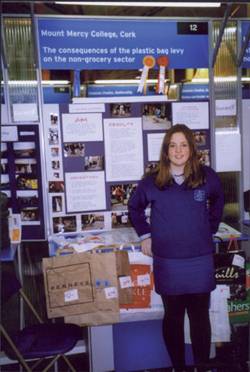| 2003 |

|
YEAR BOOK |
Mount Mercy College, Cork
|
The consequences of the plastic bag levy on the non-grocery retail sector
|

|
(1) To conduct a study of paper bags now in use in the non-grocery retail sector.
(2) To assess shoppers' attitudes and responses to the plastic bag levy. (3) To investigate changes in binliner usage since the levy was introduced. (4) To investigate the possibility of using biodegradable plastic bags in the non-grocery retail sector. |
I firstly selected ten paper bags in use in popular shops in Cork City. I ranked each of these bags on what I thought was their environmental friendliness. I sent a questionnaire to each of the ten shops. On average, their spending on bags had risen by over 1200%. Problems also experienced by retailers included storage and the initial implementation of the levy. One paper bag manufacturer reported a 20 fold increase in sales, meaning they now produce ten million bags a year!
I gave a questionnaire to 25 friends' families. I found that, when shopping for groceries, 73.9% of people use long-life bags, while when shopping for non--groceries 65.2% of people accept paper bags. Nearly everyone (91.3%) would support biodegradable plastic bags as an alternative to paper and ordinary plastic bags.
Before the levy was introduced, 86.9% of people used old plastic bags as binliners, compared to 13% who used purpose-made binliners. Now only 17.4% of people use plastic bags, with 65.2% of people now buying purpose-made binliners.
Biodegradable plastic bags seem to me to be a very viable option. They have the same strength, toughness and durability as ordinary plastic, but can degrade in anything from 60 days to 6 years, depending on how they are manufactured. When they degrade, they turn into water, carbon dioxide and a small amount of natural mineralisation. They can also be used at home as binliners and, unlike recycled plastic, can be used for contact with food.
I feel that biodegradable plastic bags should definitely be considered for use in the non-grocery retail sector.
Clare Cooney won first prize in the Junior Individual Section in the Social & Behavioural Sciences Category at the Esat BT Young Scientist & Technology Exhibition in January 2003. She also won a special award sponsored by Comhar - The National Sustainable Development Partnership.
Her teacher was Mr Pat O'Keeffe.
|
|